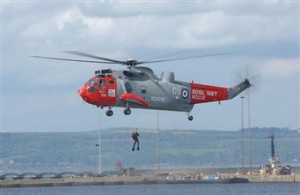
A SICK baby was airlifted to hospital in a dramatic rescue which saw Navy helicopter pilots make four attempts to land.
The hours-old child was born at the Lorn and Islands District General Hospital in Oban in the early hours of Friday morning (October 21).
Due to medical complications, the decision was made to move mother and baby to specialist care at the Royal Alexandra Hospital in Paisley.
HMS Gannet was launched at 2.45am, and picked up neo-natal paediatric specialists and equipment, before routing north west to Oban.
The autumnal weather of Scotland’s west coast, however, had no intention of making this a straightforward job for the crew from the UK’s busiest helicopter search and rescue unit.
Poor visability
Pilot Lieutenant Mike Paulet said: “Obviously it was dark at that time in the morning, but that alone does not cause us any great issue.
“However, Friday morning’s weather was really terrible and due to a combination of absolutely torrential rain and a very low cloud base we were forced to fly over the mountains at 5000-6000 feet, before descending in a clear area over the water in the Firth of Lorn to get visual with the surface.
“The journey from Glasgow to Oban would usually take us something in the region of 40 minutes, but battling through the conditions it was obvious it was going to take much longer.
“As we descended to low level over the water, the observer kept us clear of the land using the radar but we discovered that the visibility was so poor that even at just 60 feet above sea level we were effectively blind.
“With both pilots utilising a combination of night vision goggles (NVG) and the observer [navigator] Lieutenant Alex Stevenson controlling the aircraft on the radar, three approaches into Oban were attempted from different directions – all without success.”
Determined, however, that the tiny baby should receive the vital lifesaving medical help the helicopter was carrying, the team re-evaluated the options.
“By now it was about 4.30am and it wasn’t just the time ticking away which was concerning us,” explained Mike. “We were also becoming concerned about our fuel endurance”.
“We had managed to get a visual on Lismore lighthouse, just to the northwest of Oban bay. As a contingency plan, we talked about landing the helicopter on the island and waiting for daylight.
“Although this wasn’t ideal, the safety of the aircraft and all those on board was upper most in our minds. But so was the very ill baby. Taking into account our fuel situation, we decided to give it one more shot.
“Our observer, Lieutenant Alex Stevenson, once more talked us in towards the land using the radar. My co-pilot and I could only see the surface intermittently and so Alex assessed the situation and decided that we would try and approach from the north west. This meant that any land would be silhouetted against the lights of Oban town.
“It is dangerous flying in these circumstances and we rely on teamwork. Alex began to talk the aircrew around onto the best approach heading using the radar as we kept looking out for land on the NVG.
Critical
“Due to the fact that we could see very little, we had to trust him completely and fly to his instructions on our instruments.
“This time it worked. Landing at the hospital at 5am, we were able to get the paediatric specialists to the baby which was a huge relief. You just know that in circumstances like that, every second can be critical.
“There were certainly times when I doubted we were going to succeed in getting in, but, in the end, we did and the outcome was the best possible.”
After three and a half hours in Oban – which gave them time to refuel at Dunstaffnage – the Sea King was airborne once more at about 8.30am, this time with the two paediatric staff, a midwife, mum, dad and the baby, who had been stabilised by the medics, as well as the four crew, on board.
The weather was still far from perfect, but daylight helped the Royal Navy team along and they safely delivered their passengers to the Royal Alexandra Hospital in Paisley at around 9.30am.
The helicopter landed back at base in Prestwick at 10.15am – some eight hours after taking the call and after a full four hours or so of flying in the thick of some awful conditions – all adding up to a 25 hour duty period for the crew.
The baby spent the weekend at the hospital in Paisley being monitored and stabilised, before being allowed to go home to Oban today (Monday October 24) with mum and dad.
And, just 36 hours later, there was yet more drama, when the same crew was called to Argyll once more – again in yet more dreadful weather – this time on a four-hour call to assist an elderly man involved in a road crash near Lochgilphead.
The full HMS Gannet duty crew was Lieutenants Mike Paulet and Guy McCallum (both pilots), Lieutenant Alex Stevenson (observer) and Flight Sergeant Andy Dixon (aircrewman).